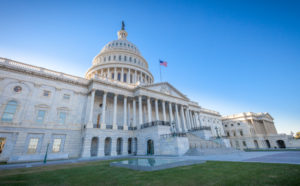The House on Wednesday evening voted against progressive lawmakers’ proposals to cut the topline of the next defense policy bill by as much as $100 billion, and blocked a provision led by the Armed Services Committee chair that would have allowed the Navy to retire nine Littoral Combat Ships (LCS).
The amendments to the House’s nearly $840 billion version of the fiscal year 2023 National Defense Authorization Act were considered during floor debate, with the lower chamber set to vote on final passage of the bill Thursday evening.

Lawmakers voted 78 to 350 to block a proposal from Reps. Barbara Lee (D-Calif.) and Mark Pocan (D-Wis.), top members of the Congressional Progressive Caucus, that would have cut the FY ‘23 NDAA topline by $100 billion.
Lee, who has introduced similar proposals in recent years, noted the amendment was structured so it would “not reduce pay or benefits for uniformed and civilian personnel or their families” and said the $100 billion would be freed up for “sorely needed other key national priorities.”
“This House again stands poised to pour over $800 billion into a defense establishment that is un-auditable, unaccountable and does little to answer the biggest threats to the safety and the welfare of our people,” Lee said on the floor. “If we reinvested that $100 billion it could pay to hire one million elementary school teachers to relieve the current teacher shortage. It could pay to power every home in America with solar energy. Or it could provide every family in America with a $700 stimulus payment.”
Rep. Mike Rogers (R-Ala.), HASC’s top Republican, said the measure would “arbitrarily strip” $100 billion out of the bill adding it would have “catastrophic effects on training and readiness” and “further postpone critical modernization efforts.”
“This amendment guts the bill. It harms our service members and their families. It severely weakens our ability to defend ourselves and our allies. Given [Russian President Vladimir] Putin’s atrocities in Ukraine and the increasing threats we face in China, Iran, North Korea and other adversaries, this is the worst time to start slashing defense spending,” Rogers said.
HASC advanced the $840 billion FY ‘23 NDAA out of committee on June 23, after adopting a bipartisan measure to boost the topline by $37 billion (Defense Daily, June 23).
A second amendment from Lee and Pocan, voted down 151 to 277, would have reversed the $37 billion topline increase and reinstated the original spending level proposed in Biden’s budget request.
“Let’s stop rewarding the building of amphibious vehicles that sink, unready projects like the F-35 that still have hundreds and hundreds of recognized deficiencies that have not been addressed and Ford-class aircraft carriers that have toilets that cost $400,000 in chemicals to flush to unclog. Yes, we flush defense dollars down the toilet. Let’s fix this,” Pocan said.
Rogers also called this proposal an “arbitrary slash” at defense spending, while Rep. Adam Smith (D-Wash.), the HASC chair, offered his support for the measure.
“One of the things I’ve always been worried about on the Armed Services Committee is if we just give [the Pentagon] more and more money they won’t spend it as well as they should. They will not have the fiscal discipline to go in there and make sure that the money is being spent wisely,” Smith said, while noting his opposition to the earlier $100 billion cut. “If we go back to the president’s number, it is $813 billion which is a four percent increase over last year’s budget. It’s not like we aren’t spending money if we stick to the president’s budget. I think that number should work and I think that’s the number we should stick to.”
Four conservative groups sent a letter to House Rules Committee leadership ahead of Wednesday’s floor debate offering support for the amendments proposed by progressive lawmakers that were aimed at cutting defense spending (Defense Daily, July 13).
Smith also led the amendment that would have allowed the Navy to retire nine LCSs, proposing to lawmakers that the House “should not be blocking the effort to save money and retire them.”
“The biggest reason that we have a problem with this is that these ships are not that old. They’re not. But they have also not turned out to perform the way they were expected. In particular, they were supposed to have anti-submarine capability. They were supposed to have de-mining capability. They have neither of those. They have also turned out to have significant maintenance problems and costs associated with simply operating them,” Smith said. “The LCS has literally no role in the counter-China fight. It has no capability that will help us in dealing with China.”
The $37 billion topline increase HASC adopted to the FY ‘23 NDAA during its committee markup included a provision blocking the Navy from retiring five LCSs (Defense Daily, June 22).
Rep. Rob Wittman (R-Va.), ranking member on HASC’s Seapower and Projection Forces Subcommittee, pushed back on Smith’s amendment, which was ultimately voted down 208 to 221.
“The bottom line is the LCS does have capability. It has a minehunting capability. It has a fast attack capability. That’s capability that we would give up in times where we need that capability. And if you’re going to do away with that capability, the question is with the savings that you would accrue, which is about half a billion dollars, what are you going to do with those dollars to create comparable capability today? The answer is you can’t do it,” Wittman said. “I respect the chairman but he is wrong. This ship does have capability against China. It is capability that is operable today. If you get rid of this ship, you have nothing and the replacement for this ship is six years out.”